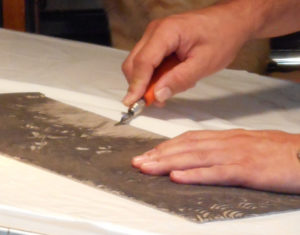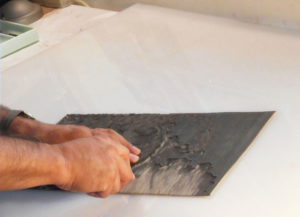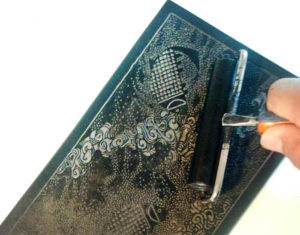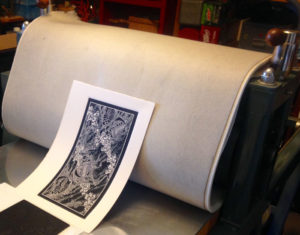About Printmaking
The term "Printmaking" refers to several distinct processes for creating multiples of a single art work. I use these processes, some the relief process and others the intaglio process, to create visual qualities and elements of pattern, shape and contrast between the black and white areas. Unlike my paintings and other graphic works, I rely on the "ink" and "no ink" patterns to create the image.
RELIEF PROCESS
Linocuts, woodcuts and collagraphs are relief prints. In the relief process, the image is printed off the raised surface of the block. The linoleum used for linocuts is different than floor linoleum and has a burlap backing. A design is drawn onto the surface of the lino-block and areas are cut away that are meant to not receive ink. When the lino-block is ready to print, ink is placed on an inking slab and rolled with a rubber roller brayer. Ink is then rolled onto the linocut. The linocut and paper are rolled through a press to get consistent images for the edition. I use an etching press in my studio to print the images, while others who may not have a press, can rub the image onto the paper. The process of inking and running the linocut through the press is done for each image.
INTAGLIO PROCESS
The Intaglio (pronounced in-TAL-yo) process includes etching, aquatints, dry point, engravings and Mezzotint. Intaglio comes from the Italian word to carve, incised or cut-in. The process has not changed much from the earliest days of its development. And the presses used today for intaglio hand printing are similar to presses used over 150 years ago.
Etchings are prints taken from a copper or zinc plate in which the image has been bitten with acid. The plate is covered with an asphaltum, which is scratched away to reveal areas of metal. The plate is placed in an acid bath. The acid bites into the exposed areas, leaving lines that have been cut into the plate that holds ink.
Aquatint is a process where the plate is etched using a fine dusting of spray paint or rosin dust that is melted onto the plate. The plate is immersed in the acid bath and the acid bites around the paint or rosin particles, creating a tone instead of a line. This process can be done many times to create a broad range of tonal areas.
Dry point creates lines without the use of acid. Dry point can be done on zinc, copper or plexiglass plates. I draw directly into the plate, creating a shallow line with a ridge or burr of metal or plexiglass on one side. Because the burr is fragile and wears away after several passes through the etching press, the number of prints in a dry point edition is usually small.
Creating each individual print requires the same attention to detail, as the plate must be inked and hand wiped after each impression has been taken. Ink is placed on the plate and pushed into the grooves and lines, and the surface of the plate is wiped clean. The plate is put onto the etching press bed with dampened paper placed on top and then run through the press under pressure to force the paper down into the inked lines.
The dampening of the paper is essential so that it is supple enough to be pressed into the crevices of the plate to take the ink. Intaglio prints are often characterized by an embossed line around the image, which is made by the edges of the plate.
THE PRINT
I am often asked, is this an original? Or, how is this different than a reproduced print or poster? An original print is the creation of a work on paper or material made by using one or more of the several printmaking mediums. Each has its own identifiable quality, but because more than one impression of each image is possible, original does not mean unique. What it does have is the artist’s direct participation in the creation of the image. It is different than a drawing or a painting that has been mechanically reproduced and sometimes has a limited edition.
Original prints are pulled by hand and should be thought of not as copies, but as original works in multiple impressions. Mono-prints with only one impression of the image are the exception. Prints allow people to collect original artwork.
THE EDITION
Edition Numbering is a manner of numbering prints that is over 100 years old. The reason for edition numbering was to keep control of the proofs in each edition and keep track of how many prints were left to sell.
The price can go up as the edition sells out. If the image is popular and more could sell than the edition, it is not ethical to pull more prints and sell them. The integrity of the artist is necessary to maintain the trust and confidence of the collector.
There are also designations in prints, such as A.P. for Artist Proof. Proofs are not considered part of the edition of prints.
The Edition Number is stated as a fraction with the total number of prints in the edition as the bottom number and the number of the specific print as the top number. If the edition is 75, the numbers would read, 1/75, 2/75, 3/75 etc
Signing Prints: Prints are numbered and signed in pencil. The name of the print and the edition number are put in the left-hand corner or in the center. The artist’s signature is in the right-hand corner.
M Fred Barraza
PO Box 611, Silver City, New Mexico 88062
575-313-0376, fredbarraza@gmail.com
Please contact us for information on future exhibitions, new work, and purchase.




